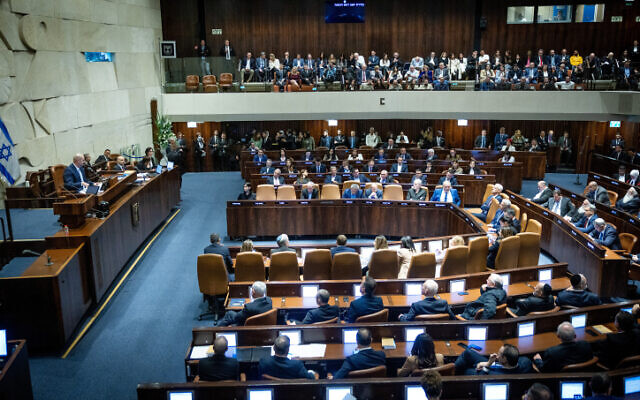“Mistakes happen. We’re all people,” National Unity party chief Benny Gantz tweeted on January 23.
It was an apology of sorts. Gantz’s party had just failed to show up to its own filibuster, allowing the Netanyahu-led coalition to amend the Basic Law: The Knesset undisturbed by the opposition.
The amendment that passed that night expanded the “Norwegian Law,” which allows cabinet ministers to resign their Knesset seats in favor of the next person on their party’s list without losing control of the seat. If the minister later resigns from the government, they are automatically reinstated in the Knesset and their replacement is bumped out.
The original law allowed up to five extra MKs per party; the new version expanded that to 10 as long as the replacements numbered fewer than one-third of the total faction. That is, the amendment was tailor-made to allow the 30-seat Likud, the ruling party, to add 10 full-time MKs to replace those appointed to the cabinet.
Likud wanted the law to pass; the opposition declared its opposition and announced a filibuster. It hoped to slow the legislation down, prevent other votes from coming up, and force the coalition to spend a late night voting down a long list of legislative “reservations.” The filibuster also offered a handy opportunity for public relations, a chance to produce a quotable record, sound bites and video clips around the parliamentary drama.
Get The Times of Israel's Daily Edition by email and never miss our top stories
The debate began. National Unity MK Orit Farkash-Hacohen, the former science minister, took to the podium and launched into her speech. An hour and a half later, as she wound down, opposition whips went to call in her replacements — and discovered they’d all gone home.

A plenum session on forming the government in the Knesset on December 29, 2022. (Yonatan Sindel/Flash90)
Farkash-Hacohen stepped down from the podium to a coalition surprised at its luck and eager for an early night. It wrapped up the debate, held its votes and was driving home by 10 p.m.
The missing MKs
Mistakes happen, said Gantz. But the failed filibuster wasn’t the exception that Gantz seemed to suggest. It’s the norm.
On December 22, a week before Netanyahu’s government was sworn in, the watchdog group Bodkim released figures showing the average number of hours each party’s lawmakers had spent in the parliament building between November 16 and December 20.
The numbers were startling. The six factions of Netanyahu’s right-religious alliance averaged 113 to 197 hours per MK; the center-left and soon-to-be opposition factions averaged roughly half that, 68 to 108.
1/ על רקע ההאשמות ההדדיות בין חברי הכנסת בנושא הנוכחות במשכן הכנסת, החלטנו לפרסם נתונים במספר קטגוריות.
א. ממוצע מפלגתי של נוכחות במשכן הכנסת.
סך השעות הכולל שבילו במשכן כל חברי הכנסת במפלגה בין ה-16/11 ל-20/12, לחלק למספר חברי הכנסת במפלגה.
התוצאות מובהקות
????-> pic.twitter.com/2YFg8nCKXf— בודקים (@bodkim2022) December 22, 2022
Defenders of the outgoing Bennett-Lapid coalition protested Bodkim’s claim. Cabinet ministers, they noted, are members of the Knesset but do most of their work outside the parliament building, skewing the results against those in power. So Bodkim crunched the numbers sans the ministers. Very little changed. The top five parties were still right-religious factions, six of the bottom seven were in the opposition.
ב. חישבנו את אותו הנתון, אבל הפעם הורדנו מהרשימה את חברי הכנסת שהם גם שרים או סגני שרים, מכיוון שלאלו יש משרד נוסף.
התוצאות עדיין מובהקות לטובת הקואליציה המסתמנת ויחד עם זאת, 4 המפלגות שבהן יש שרים/סגנים שיפרו במעט את מצבן, מה שדרדר את הליכוד 3 מקומות אחורה. pic.twitter.com/hCBrs3spzl— בודקים (@bodkim2022) December 22, 2022
The gap was so great that the center-left could boast just three MKs in the top 30 when it came to hours spent in the Knesset.
The defenders tried another tack. “Last time we checked,” Bodkim wrote on January 6, “we got complaints from the ‘Lapid bloc’ that… ‘Netanyahu bloc’ members are busy with [coalition] negotiations [in the Knesset], which raises their ranking.”
So the group ran the numbers for January 1-5, after the government’s swearing-in, when “the ministers had already changed over and the negotiations were finished.” The graphs didn’t change.
נוכחות המפלגות השבוע במשכן הכנסת.
בפעם הקודמת שבדקנו, קיבלנו תלונות מתומכי "גוש לפיד" שלשרים לשכות נוספות – מה שמוריד את הדירוג, ובנוסף חברי "גוש נתניהו" עסוקים במשא ומתן מה שמעלה את הדירוג שלהם.
הפעם השרים התחלפו והמשא ומתן נגמר אבל המגמות נותרו אותן המגמות. pic.twitter.com/kxGfbxA6uw— בודקים (@bodkim2022) January 5, 2023
It’s a basic truth of Knesset life, irrespective of which side is in power: The center-left doesn’t show up.
There are always notable exceptions, of course. Labor MK Gilad Kariv is a fixture in the Knesset Law Committee; scarcely a meeting goes by without him fervently debating the principles and the minutiae of the government’s new judicial overhaul. Yesh Atid MK Vladimir Beliak is similarly present and engaged on budget questions in the Finance Committee. But these are exceptions that only serve to highlight the general rule. Both men often find themselves alone in the trenches.
The failure to muster a filibuster against the Norwegian Law was unique only in the special irony of the situation — an absentee opposition failing to turn up to battle against the coalition’s effort to be even more present.
The missing alternative
This absenteeism is no minor quirk. There’s a good reason that opposition MKs feel no urgent need to be seen defending their constituents or fighting for their beliefs. In Yesh Atid, Yisrael Beytenu, National Unity and other factions that don’t hold primary elections, the party leader is the only person an MK must impress to keep their job. If the leader doesn’t value the work of the Knesset — if, for example, they are rarely seen walking its halls — then there’s little personal benefit for the rest of the party list in showing up.
But there’s a deeper conclusion to be drawn from this absenteeism, especially when compared to the right’s record-breaking filibustering that choked the Bennett-Lapid coalition’s ability to pass legislation all last year. Is it too much of a leap to suggest that the center-left’s failure to show up to committee meetings or plenum debates is simply a sign of disinterest? That those who feel no need to participate might simply not have much to say?

Opposition leader Yair Lapid attends a rally against Prime Minister Benjamin Netanyahu’s new government and its proposed judicial overhaul, in Tel Aviv on January 21, 2023. (Gili Yaari / Flash90)
The protests against the judicial overhaul in recent weeks have been an extraordinary sight, winning praise even from right-wing commentators who support the government’s reform. Over 100,000 Israelis at one protest, tens of thousands getting soaked in a January rain at another. The fear is real, the anxiety palpable. And the leadership all but absent.
It isn’t just that center-left leaders didn’t bother to show up at the early protests until public criticism forced them to. None have come forward to clarify what the fight is about. Slogans about the death of democracy aren’t sufficient. It isn’t enough to know what one doesn’t want to happen; the center-left doesn’t seem to have any idea what it does want to happen.
Much ink has been spilled in the Hebrew-language media about the growing influence of the Kohelet Policy Forum, a conservative think tank in Jerusalem with anonymous foreign donors and (to the center-left) maddeningly American habits of thought. Kohelet researchers played key roles in developing many of the new government’s policies, making the organization a bogeyman of the center-left imagination.
But this focus is a cop-out, a cover for the fact that the center-left has no equivalent policy shop of its own. It’s easier to frame the government’s policy push as a nefarious, foreign-inflected conspiracy than to respond to right-wing proposals with ideas of one’s own. On judicial or constitutional reform, economic policy, natural gas, Palestinians, Iran and countless other questions, the center-left sometimes knows what it opposes, but can rarely articulate what it supports.
By failing to advance a serious alternative to the government’s judicial remake, the center-left’s blind resistance to all reform fails to challenge rightist ideas. Instead, it empowers Levin’s counter-revolution and pushes the country toward the very crash that center-left activists claim to be fighting to avert.

Israeli protesters attend a rally against Prime Minister Benjamin Netanyahu’s new government in the coastal city of Tel Aviv on January 21, 2023. (Ahmad Gharabli/AFP)
Despair
The sense of impending doom among center-left voters is partly a function of this vacuum of leadership and policy. A political community is watching its slow-motion marginalization and decline — a community that believes it has carried other Israeli sectors on its back for a long time, by choice when it was the majority and increasingly by diktat now that it is not.
This is not an entirely unreasonable view of things. Every Israeli knows, though not all may like to admit, that if secularist Tel Aviv didn’t send conservative-religious Jerusalem roughly a billion shekels a year through the national tax system, Jerusalem would collapse. Yet secular Tel Avivim are denied civil marriage because of the votes and cultural preferences of those religious conservatives.
And while right-wing ideologues have in recent years been busily constructing a narrative of a conservative underclass victimized by a “white, privileged” left-wing elite — the Israeli right has borrowed more than a few notions from the American left — a very great deal of Israeli poverty is actually a function of the lifestyle choices of conservative communities. Vast numbers of Haredi men and Arab women refuse to join the workforce for reasons of ideology and tradition rather than structural inequities. Yet secular Israel is paying a vastly disproportionate part of the bill for a health care system that keeps these willfully impoverished Israelis healthier and longer-lived than much of the rest of the developed world.
These realities, too, are a growing part of center-left discourse. The right has built its new alliance on a rhetoric of grievance. The left, lacking political leadership and afraid of what lies on the other side of its own decline, is beginning to do the same.
This bitterness and fear is what drives the talk of democratic and economic collapse, of resisting a looming “dictatorship” and even of outright civil war. On the right is a leadership that doesn’t believe it owes Israelis answers about how their rights will be safeguarded after the reform is passed; Justice Minister Yariv Levin continues to refuse to give press interviews. And on the center-left is a leadership that refuses to present alternatives, produce policy ideas of its own, or even just show up to the fight, either in parliament or in the streets.


